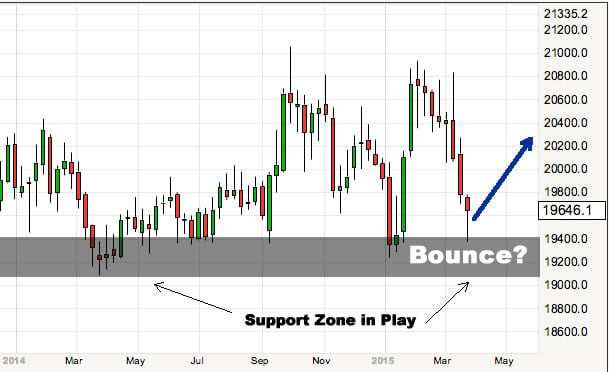New Zealand Dollar Strength Against the Pound Forecast to End
The outlook for the NZ Dollar is dominated by first quarter inflation which is due for release on the 19 April, closely followed by the next RBNZ meeting on the 29th.
These key events, due in April, come as the British pound suffers a particularly negative bout of weakness against the antipodean currency.
A presumption for lower inflation readings suggest the RBNZ may be forced to reverse part of their 100bp interest rate rises conducted in 2014.
With interest rates being key to exchange rate direction, the prospect of a cut by the RBNZ is an overwhelming negative as it suggests less global currency will flow to NZ to take advantage of the now smaller returns that cash held in the country demands.
This will aid the pound which has come under significant pressure against the kiwi dollar in 2015, could New Zealand’s April calendar coincide with technical support to arrest declines in GBP-NZD?
As the below shows, we are at an important juncture.
We see the pound to New Zealand dollar exchange rate at 1.9777 at the time of writing, the pound is thus testing the lower end of the longer-term 2014 range.
The region above 1.90 did not crack over the course of the pervious 12 months; will the same be true in 2015?
Fundamental predictions (as opposed to this technical viewpoint) issued by Lloyds Bank suggests that this upside bias is indeed preferred, see below.
As we mentioned previously though, the NZD is still predicted by many to enjoy a strong 2015, so the prospect of a break of this support area cannot be discounted while a tear-away rally above 2.10 is unlikely.
NB. Currency quotes in this piece refer to the wholesale market. Your bank will affix a discretionary spread when transferring money internationally. However, an independent provider will seek to undercut your bank's offer, thereby delivering up to 5% more currency in some instances. Please learn more.
Forecasting a Stronger USD v the NZD
One factor that will likely act in sterling’s favour in coming months is the prospect of a stronger USD.
If the US dollar pushes the New Zealand dollar lower we could see NZD weakness occur in other key currency pairs.
The New Zealand dollar has come under pressure against the USD over the past month, dipping to a low of 0.7177.
However, less dovish comments at the most recent RBNZ meeting provided a modest uplift for the New Zealand currency.
The RBNZ maintained a neutral policy stance at its March meeting, slashing the projected 90-day interest rate path and forecasting interest rates to remain unchanged until 2017.
“Balanced against this, the Bank hinted that if headline inflation remains low, (i.e. settles around 1% y/y), this could prompt them to cut rates,” say Lloyds Bank Research in a note to clients released at the close of March.
Inflation figures will therefore be closely watched to gauge the potential for RBNZ rate cuts.
“We believe the combination of heightened speculation of RBNZ policy easing and increasing USD optimism should maintain the downside bias in NZD/USD. We forecast the pair to reach 0.70 by Q3,” say Lloyds.
Longer-Term Forecasts for the Pound Against the New Zealand Dollar
The prospect of a stronger USD is likely to aid the GBP higher against the New Zealand unit.
However, the UK is itself due to see interest rate rises in coming months.
So where the New Zealanders could be about to cut, the UK’s next move will most likely be to raise rates.
This policy divergence works in favour of a higher GBP-NZD in much the same manner as we have seen in the much-publicised GBP-EUR rally.
As such, Lloyds Bank Research say they are predicting an exchange rate of 2.00 in June, 2.11 in September and then 2.14 at the end of 2025.
Looking at their 2016 forecasts, Lloyds see 2.15 in March, 2.18 in June and 2.18 at year-end 2016.
Be aware though that elections in the UK are due in coming months, something that will likely spark a fresh bout of GBP volatility which could undermine all the forecasts seen here.
With a hung parliament, or minority government, being seen as the most likely outcome havoc could be wreaked on sterling exchange rates.













